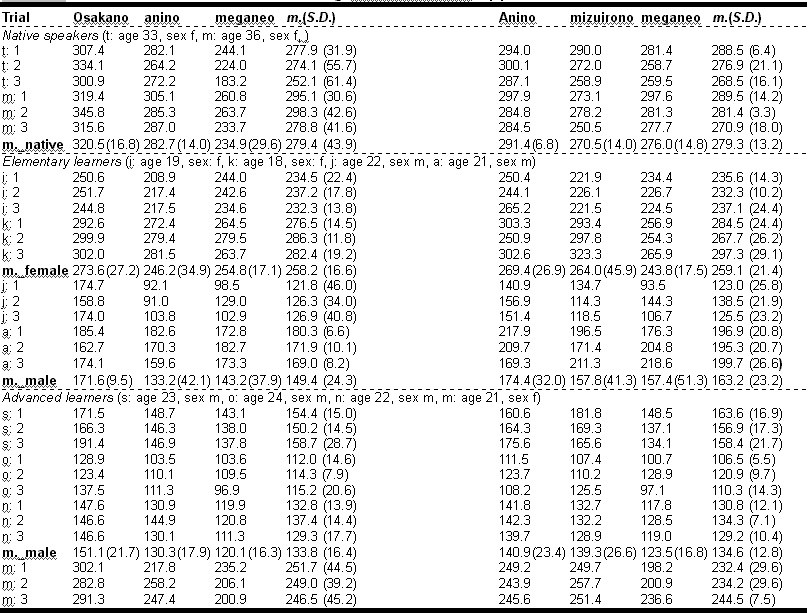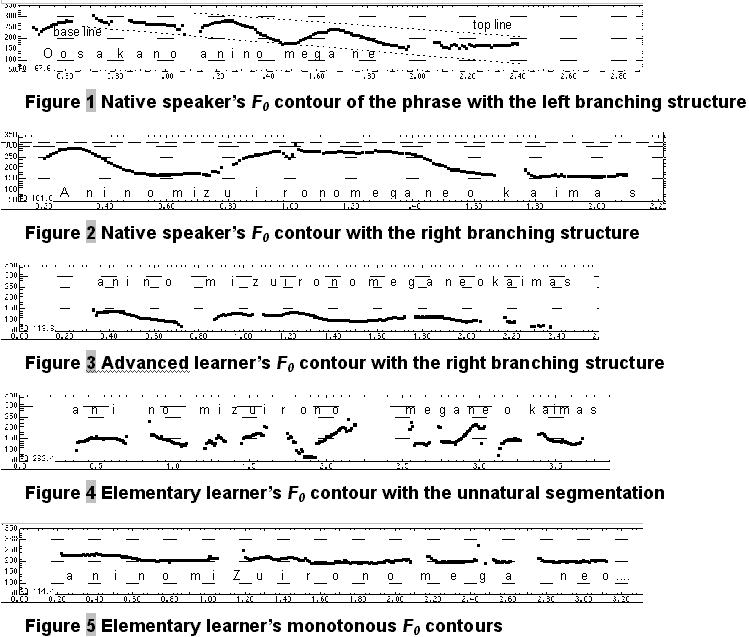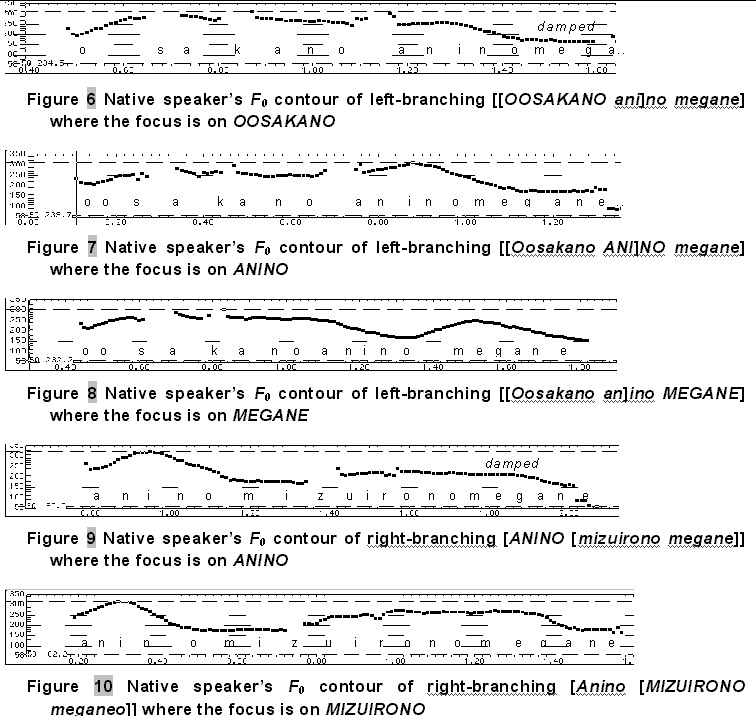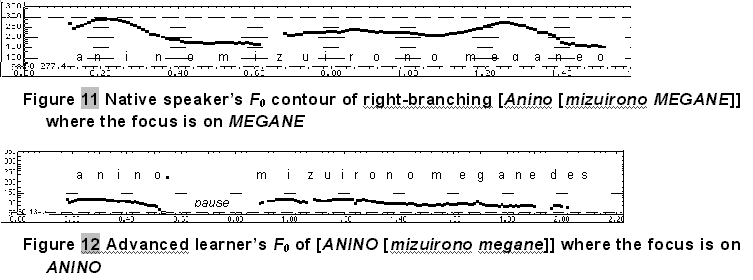Pitch Descending by British Learners of Japanese
Katsumi NAGAI
Osaka University Graduate School of Language and Culture
1 Introduction
In this pilot study, Japanese compound phrases spoken by British learners at two different levels are analyzed to examine the pitch contours and their peaks. The syntactic structure like the direction of branching seems to affect the realization of compounded pitch contours. Effect of the contextual focus is also examined. Language teachers need to know that natural speech sounds by Japanese native speakers are considered a dynamic compound of the both effects.
1.1 Markedness of right branching structure
What is the difference between 'A and B but C' and 'A but B and C'? According to Ladd (1988), the accents at the beginning of the B and C are slightly higher when they follow but than when they follow and. He pointed out that these rises and falls of stress were caused by the difference of their syntactic structures between [[A and B] but C] and [A but [B and C]]. Likewise, a new accent phrase with a stress pattern of [[SW]W]] is created by applying Compound Stress Rule of Strong-Weak recursively as in [[COMPUTER class] instructor]1 and [[COMMUNITY center] building] (Kubozono 1994: 90ff.). If the compound phrases have a right branching structure, the structure works as a block of the Compound Stress Rule in English and creates [W[SW]] structures as seen in [kitchen [TOWEL rack]] and [chemistry [RESEARCH laboratory]].
Markedness in right branching structures is effective not only in English compound words but also in Japanese compound phrases. Kubozono (1992:175) found that the right-branching-markedness can be observed in Japanese, too. That is, the right branching structure of Japanese compound phrases is a marked structure which cannot render natural prosodic procedures such as the sequential voicing (Otsu 1980) and accentual phrasing of compound phrases. Compound Accent Rule, which makes one accent phrase with two phrases, is not applied to right branching structures. Two accent phrases are made instead. The Japanese accent of the compound phrase whose structure of the components is [[AB]C], for example, becomes one new accent phrase [ABC]. But the one whose structure is [A[BC]] remains as two accentual phrases [A][BC] as seen in [[kokusai re'ngo] [kensho]] and [kokusai rengo ke'nsho] ("United Nation Charter") and [[ni'chibei ][ampo jyo'yaku]] and [ni'chibei ampo jyo'yaku] ("Japan-US Security Treaty").
The right branching structure of compound words and phrases shows its markedness in both English and Japanese as viewed above, though the two languages do not share ways realizing phonological accent. While English speakers change the stress pattern of English compound words, Japanese speakers change the segmental pitch. It is then plausible that these characteristics have an effect on the application of Compound Accent Rule. If the rule found in speech of advanced English learners of Japanese is more similar to native Japanese speakers' than elementary learners', it can be used as a yardstick of learners' achievement in Japanese phonology.
1.2 Declination in fundamental frequency
The automatic physical lowering of F0 needs to be distinguished from the linguistic tonal lowering (Hyman 1975: 225ff.). Pitch usually refers to the perception of physical fundamental frequency (F0) in the field of acoustic analysis. A progressive fall in F0 to the end of speech is universally observed because the F0 varies with the rate of vibration of the vocal folds which the puffs of air create and air in our lungs has its limit. Fant (1956, quoted in Laver 1994:451) clarified that average values for F0 in conversational speech in European languages are about 120 Hz for men, 220 Hz for women, and 330 Hz for children around ten years old. The highest F0 by a single speaker can be twice of lowest F0. Though there is not necessarily a linear correlation between phonological pitch and phonetic F0, the pitch of a speech sound depends directly upon the frequency of vibration of the vocal folds (Gimson & Cruttenden 1994:22). Pitch and F0 is treated as synonyms in this paper because assuming one-to-one correspondence between them does not affect the discussion.
2 Experiment
2.1 Aim
The difference between stress accent and pitch accent is expected to bring about difficulties for learners of Japanese because whether or not the learners of Japanese can properly control pitch and downstep2 largely affect the naturalness of their speech. As seen above, natural descending of pitch contour in Japanese is blocked when the syntactic structure has a marked right branching structure. Experiments in this paper aim to examine the effect of syntactic structure on blocking downstep and an intonational rule. The questions are: (1) "Is the downstep of Japanese compound phrases spoken by English speakers blocked by the syntactic branching structure?", and (2) "Is an intonational phrasing rule (mentioned below) blocked by the syntactic branching structure?" As a pilot experiment, last but not least aim is to observe characteristics of pitch controls by ldearners of Japanese.
2.2 Materials
All sentences are written in hiragana without Chinese characters. Analyzed materials are sets of Japanese compound phrases embedded in natural conversations. First one is Sono okane-de nani-o kai-masu-ka? ('What will you buy with the money?') --- Oosaka-no ani-no megane-o kai-masu. ('I will buy glasses for my brother in Osaka.'). This set is originally taken from Fujisaki (1989:280ff.) and the reply includes a compound phrase has a left branching structure ([[Oosakano ani]no megane]). Because the test word Oosakano is anaccented and the adjacent a'ni has a HL tone pattern, Oosakano plus a'nino are expected to form one larger anaccented prosodic compound Oosakano-ani(-no). This effect is called intonational phrasing and is said to be blocked by a right branching structure of the phrase.
Another set is different in its answer to the question Sono okane-de nani-o kai-masu-ka? Ani-no mizuiro-no megane-o kai-masu. ('I will buy my brother's glasses in light-blue.') This second sentence includes a right branching structure [Anino [mizuirono megane]] in its compound phrase. A larger compound phrase Anino-mizuiro(no) cannot be made because of its right branching structure.
2.3 Subjects
Eight British learners of Japanese and two native teachers of Japanese attended this experiment. The advanced group studied Japanese for three and half years before this experiment. They also have experience of studying Japanese in Japan for one year. The elementary group studied Japanese one and half years.
2.4 Procedure
Subjects were asked to read the Japanese test sentences in a sound proofed recording room. They were given a brief explanation of the experiment beforehand, and allowed some practice for a few minutes before the recording. They repeated each question and answer five times from the top of a list. They were asked to repeat the whole sentence or conversation when they got confused. The first and the last recording were omitted to reduce unnaturalness caused by their unfamiliarity with the sentence and their fatigue.
Their utterances were caught with a sensitive condenser microphone (Senheisser MKH815) and recorded on a digital tape recorder (SONY PCM-2700A) through a microphone amplifier (Soundcraft 200B). The digitized sound in sampling frequency of 16KHz were loaded into a Sun workstation and analyzed with a speech analyzer package (X-Waves) on the Unix workstation. The peak F0s corresponding to each element of the compound phrase in Japanese were measured.
2.5 Results
Table 1 shows the trend of descending F0 contours is apparent from the data.

Table 1 Peak F0s of the Japanese compound phrases
2.6 Discussion
Because of the intonational phrasing law, Oosakano-ani(-no) makes one compound in Figure 1. The declination of F0 by native Japanese speakers is also observed when the compound phrase has a left branching structure. The F0 contour in Figure 1 declines toward the end of an utterance. Figure 2, which has a right branching structure, shows its higher second peak of pitch contour mizuirono than the one in Figure 1. Figure 1 has an unmarked left branching structure, which allows the application of the natural downstep. Figure 2, on the other hand, has a right branching structure, which hinders the application of the natural downstep. Regardless of whether the markedness itself raises the pitch or invokes another device called 'metrical boost3', the right branching structure gives an effect to pitch in Japanese. In other words, the difference of F0 contours can be explained by their syntactic structures.
Elementary learners of Japanese show less difference between the right branching structure and left branching structure. Utterances of advanced learners are, as expected, far more natural than those of elementary learners to the ears of native speakers of Japanese. The advanced learners' downsteps, the differences among the F0 peaks by male advanced learners, are smaller in spite of their naturalness in pronunciation as seen in Figure 3. One problem remarkable observed in elementary level learners is their unnatural segmentation of words and phrases as shown in Figure 4. In such a case, language teachers had better let the students know that putting a pause between a noun and particle is unnatural in Japanese. Secondly, in addition to a lack of natural downsteps of the sentence, a number of unnatural pitch alignments on the elements of the compound phrases are observed in the learners' data. Instruction in basic pitch patterns of Japanese words would be necessary especially for advanced learners. Thirdly, a lack of natural ups and downs of fundamental frequencies, as seen in Figure 5, causes remarkable trouble. This can be seen in both elementary and advanced learners of Japanese as seen below. These F0 patterns sound not fluent but monotone. In this case, even a pause between anino and mizuirono is likely to be deleted and the two phrases are linked. Pedagogically, elementary learners should not delete pauses at the borders of phrases because the proper pause between syntactic boundary works as a marker for precise perception of speech sounds.
3 Additional Experiment
The experiment above reveals that the right branching structure shows its markedness by blocking natural downstepping of F0. However, various linguistic factors, apart from syntactic structure like the direction of branching, is considered to influence prosodic organization. This additional experiment aims to investigate the effect of the focus on a part of compound phrases in Japanese. Further questions and answers as below are recorded using the same sentences in Fujisaki (1989:280-281). Conversations which begin with the interrogative sentences were read to induce a focus on one element of the compound phrases. Examples to put a focus on the word Osaka are: Tokyo-no a'ni-no me'gane-desu-ka? ("Are the glasses for your brother in Tokyo?') --- Iie, Oo'saka-no a'ni-no me'gane-desu. ("No, the glasses are for my brother in Osaka.")
The F0 contours by native Japanese speakers in this additional experiment imply the effect of downstep and its blocking, which are obscured by the effect of contextual focus. The phrase at the beginning of the sentence (Oosakano and Anino) is usually uttered with prominence. Fujisaki (1992: 170) says the first accent phrase with focus on it remains essentially unchanged against changes in the focal condition and in the syntactic structure, and is similar to its value when the word is uttered in isolation. When the first phrase has a focus, pitch contours of the following phrases are damped as seen in Figure 6 and Figure 9. The third phrase (megane) loses its prominence. This effect of the first phrase is seen in Fujisaki (1987:287), too.
Figure 7 is interesting because the utterance has a left branching structure ([Oosakano ani]no megane]]) and has a focus on ANI. The natural utterance without intended focus should have a higher primary pitch on its first phrase ([[OOSAKANO ani]no megane]]) than the second one. The foci on the compound phrase in Figure 7 are on both the first and the second phrases, and the third phrase (megane) is evidently damped. It is a case of contradiction between the default syntactic structure which required the focus on its first phrase and the preceding context which required the focus on its second phrase. A focus on the second phrase in Figure 10 (MIZUIRONO) did not damp the third phrase (megane).
Little effect of focus is seen in the utterances of elementary learners except some cases. The figures of elementary learners imply that controlling the pitch with contextual focus is difficult for them. Slight effects of focus are observed in the data of advanced learners. One of the important strategies by advanced learners is putting pauses before and after the accented phrase to compensate for their difficulty in raising pitch (Figure 12). Speech sounds can be broken into a chunk by putting a pause between the sounds, and the chunks are closely connected with the syntactic structure such as the direction of branching. Native speakers can change pitch dynamically and harmonically. Putting a pause is considered to be a pedagogically useful and important strategy for advanced learners who have difficulty in producing the natural pitch pattern with a focus.
4 Conclusion
Native speakers often hear the unnatural accents of foreign students who have reached a very advanced stage in their acquisition of the language. Learners' prosodic characteristics are closely connected with the rhythm and intonation of their target language, and the acquisition of natural prosodic structure of a second language is difficult even for advanced learners. Since the intonation in Japanese is mainly realized by ups and downs of pitch, native speakers' natural change in pitch is an important target for advanced learners. Observing fundamental frequencies on a computer display has turned out to be an effective and objective method to evaluate the learners' pronunciation. Appropriate control of pitch contours is indispensable not only for distinguishing minimal pairs but also for more natural utterances in Japanese.
As far as the phonological markedness of compound phrases is concerned, English and Japanese share the direction of syntactic branching. The result of this experiment showed that elementary learners can hardly show natural downstep triggered by the left branching structure. Most common and prominent focus is consistently on the first phrase. The second and third foci are often well-formedly blurred, which seems to be another goal for advanced learners. Learners who cannot change the pitch of compound phrases by any means can resort to pause insertion as a substitute.
5 References
Beckman, M. (1992). 'Intonational form and intonational function in Japanese and English'. Proceedings for International Symposium on Japanese Prosody. Nara, Japan.
Fromkin, V. A. (ed.) (1978). Tone: a linguistic survey. New York: Academic Press.
Fujisaki Hiroya. (1989). 'Nihongono Onchono Bunsekito Modelka'. In Nihongoto Nihongokyoiku. Vol.2 Tokyo: Meiji Shoin.
Fujisaki Hiroya. (1992). 'The Role of Quantitative Modeling in the Study of Intonation'. Proceedings for International Symposium on Japanese Prosody. Nara, Japan.
Hyman, L. M. (1975). Phonology: theory and analysis. New York: Halt, Rinehart and Winston.
Kenworthy, J. (1987). Teaching English Pronunciation. Harlow: Longman
Kubozono Haruo. (1988). The Organization of Japanese Prosody. Ph.D. dissertation, Department of Linguistics, Edinburgh University.
Kubozono Haruo. (1992). 'Japanese Prosody and Prosodic Theory.' Proceedings for International Symposium on Japanese Prosody. Nara, Japan.
Kubozono Haruo. (1995). Gokeiseito O'n'inkozo. Tokyo: Kuroshio.
Ladd, D. R. (1984). Declination: a review and some hypotheses. Phonology Yearbook. 1. 53-74.
Ladd, D. R. (1992). 'Current Theories of Prosody: an Introductory Sketch'. Proceedings for International Symposium on Japanese Prosody. Nara, Japan.
Ladefoged, P. (1996). Elements of acoustic phonetics. Chicago: University of Chicago Press.
Laver, J. (1994). Principles of phonetics. Cambridge: Cambridge University Press.
Otsu Yukio. 1980. 'Some aspects of rendaku in Japanese and related problems.' MIT working papers in Linguistics 2. 207-227.
6 Figures



(c) Katsumi NAGAI 1998 : Jump to the
top,
Centre for Research and Educational Development in Higher Education, and
Faculty of Education,
Kagawa University, 760-8521 JAPAN



